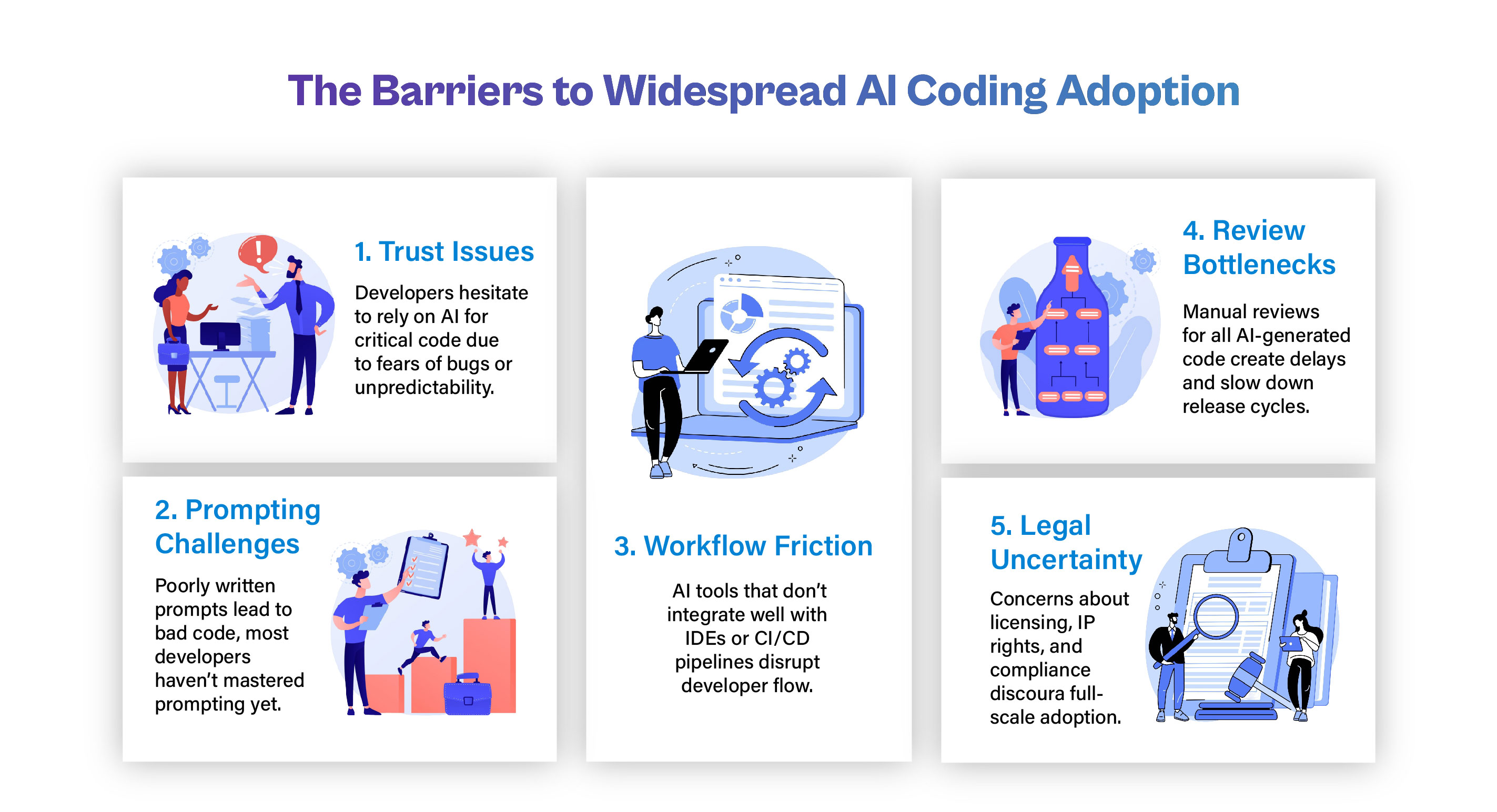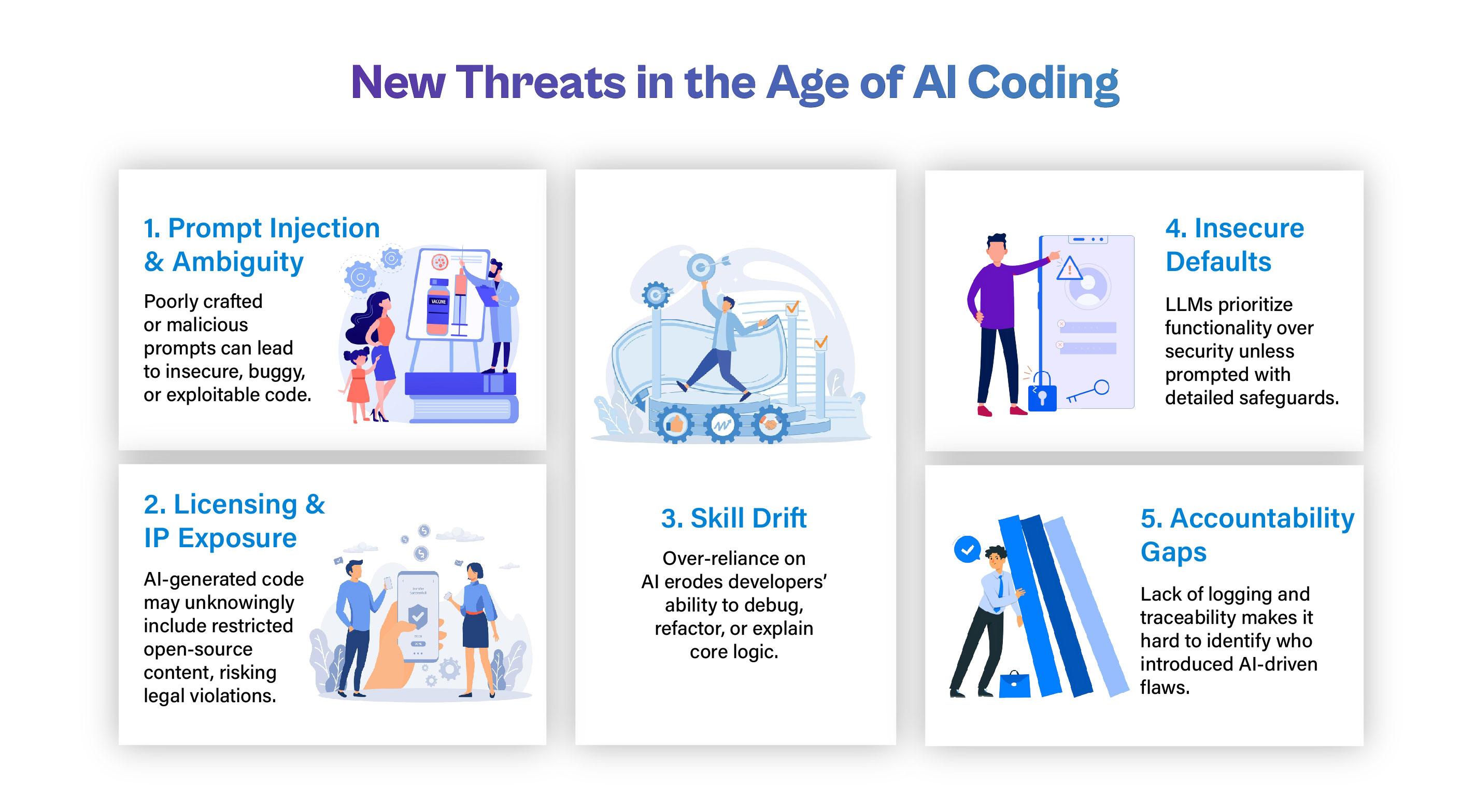




On a Tuesday in Bangalore, junior developer Priya was tasked with a simple UX update. Typically, this would mean days of design work. But today was different. By evening, Priya had a fully functional, mobile-ready, backend-connected prototype running in the dev sandbox.
She achieved this remarkable feat by rarely touching a design tool or writing much code manually. Instead, she conversed with an AI coding assistant in her IDE. Prompts like "Generate a responsive React form with two-factor auth" and "Add backend POST handler using Express" quickly transformed into executable code.
This is vibe coding in action: a new kind of flow where ideas move directly from thought to implementation, empowering developers like Priya to wear many hats and accelerate projects like never before.
Don't let the whimsical name "vibe coding" mislead you, it's profoundly changing software development. Coined in February 2025 by Andrej Karpathy, it describes a new paradigm where developers interact with powerful AI models (LLMs) using everyday language, rather than line-by-line coding. Karpathy advocated "giving in to the vibes" and letting AI manage the tedious work.
This concept rapidly gained traction, especially after OpenAI's Greg Brockman demonstrated LLMs' ability to generate complex code from simple instructions in May 2025. It became clear these AIs were genuinely useful, hitting a "utility threshold."
At its core, vibe coding is a "code first, refine later" approach. Developers express their intent, and AI translates that into executable code. It’s an AI-powered workspace where intelligent assistants automate tasks and suggest solutions, keeping developers in a creative flow state focused on problem-solving and design. For agile teams, it enables faster prototyping and iteration. While LLMs are powerful, human expertise remains crucial for complex challenges, code quality, and optimization.
Forget those simple AI chatbots. In 2025, developers will have a whole arsenal of sophisticated, AI-powered coding environments designed specifically for "vibe coding." These aren't just add-ons; they're fully integrated solutions that help you create, change, reorganize, and even debug your code alongside your team.
Ultimately, these tools are completely transforming not only how individual developers write code but also how entire engineering teams collaborate.
Remember when GitHub Copilot was just "autocomplete on steroids"? Well, it's grown up! It's now the go-to AI assistant for over 2 million developers, from open-source contributors to big enterprise teams.
The Enterprise edition, which came out in 2025, really cranks up the power:
Copilot is a big deal in industries with strict rules, where you need to track everything, stay compliant, and move fast. Many organizations now treat it as a formal part of their software development lifecycle, from planning out tasks to reviewing projects after they're done.
Cursor is basically a reimagined version of VS Code, built from the ground up to be an AI-native IDE. It cleverly mixes natural language conversations with deep code editing capabilities. It's not just a plugin; it's a completely fresh take on the developer experience.
Here are some of its value-adding features:
Cursor is a favorite among frontend teams, startups, and developers who love to iterate quickly on their local machines. Its minimal context-switching really keeps you in a high-momentum workflow.
Powered by advanced models like GPT-4.5 and GPT-4-turbo, ChatGPT when used for coding feels less like an autocomplete engine and more like a wise senior engineer. It can chat about big architectural decisions, help you dig deep into debugging tricky problems, and even explain why it made certain choices.
Its capabilities include:
You'd use ChatGPT for:
If Copilot is all about speed and being embedded in your daily coding, ChatGPT is more about deliberate, strategic thinking, perfect for tasks that involve a lot of design work or dealing with older systems.
Replit AI has become like the Swiss Army knife of vibe coding, especially loved by independent developers, educators, and anyone who wants to quickly build prototypes.
Here are its standout features:
Replit really shines for building Minimum Viable Products (MVPs), hackathons, and early-stage product development. Think of it as Heroku meets GPT: fast, expressive, and super easy to use.
The vibe coding world is incredibly flexible and constantly evolving. There are also specialized tools filling important niches:
Other emerging players like Tabnine Next, CodeGeeX, and JetBrains AI Assistant are all competing to offer the best customization, speed, and control for developers.
Despite all the buzz, the tech industry is seeing a pretty mixed bag when it comes to adopting AI in coding.
GitHub's report from February 2025 showed a truly staggering figure: 55% of the code in AI-assisted projects was generated by Copilot. Think about that, over half the code being written isn't coming from human keystrokes anymore! This highlights an incredible leap in AI's capability and its direct impact on developer output.
And yet, when you look at the broader picture, the State of AI 2025 developer survey tells a different story. It reveals that a significant 69% of developers still generate less than 25% of their code using AI tools. This shows there's a clear gap between the potential seen in highly optimized, AI-assisted projects and the day-to-day reality for most developers.
This noticeable discrepancy isn't just a quirk; it stems from several critical challenges that organizations are actively grappling with.

Developers are naturally cautious. They're hesitant to fully rely on AI-generated code, especially when it comes to mission-critical systems, sensitive data, or security-sensitive applications. The fear of introducing subtle bugs, vulnerabilities, or unpredictable behavior means a significant human oversight is still preferred, leading to slower adoption in high-stakes environments. Building confidence in AI's reliability and consistency is a major hurdle.
Just like any powerful tool, AI coding assistants require skill to wield effectively. Writing good prompts is an art form. Vague or poorly structured prompts inevitably lead to vague, irrelevant, or even incorrect code output. Developers need to learn how to be specific, provide adequate context, structure their requests, and iterate on prompts to get the desired results. It's a new muscle memory to develop, and not everyone has mastered it yet. This requires dedicated training and practice.
The effectiveness of AI tools often boils down to how smoothly they fit into existing workflows. If an AI tool isn't deeply embedded within the developer's Integrated Development Environment (IDE), or if it doesn't seamlessly integrate with Continuous Integration/Continuous Delivery (CI/CD) pipelines, it can actually slow teams down rather than speed them up. The friction of context-switching or manual copy-pasting significantly reduces the real-world usefulness and perceived value of these tools.
A common organizational policy is to require manual review of all AI-generated code, regardless of its simplicity. While crucial for quality and security, this can create a significant bottleneck. If human review processes aren't updated to handle the increased volume and unique characteristics of AI-generated code, the "throughput" of development can actually slow down, negating AI's efficiency gains. New, more efficient review workflows are urgently needed.
Legal and compliance teams are grappling with uncertainty around AI-generated code, particularly concerning open-source licenses, intellectual property (IP) liabilities, and copyright infringement. The absence of clear legal precedents and organizational policies fosters caution, especially for companies with proprietary code or strict regulations.
This creates a stark divide: early adopters are seeing huge productivity gains, while many others are struggling to fully leverage AI. For engineering managers and tech leads, the key challenge is bridging this gap with strategic processes, careful tool selection, and targeted training.
Vibe coding isn't just about making individual developers more productive; it's fundamentally reshaping business strategy and how companies deliver software. The ripple effects are profound, touching everything from project timelines to team structures and even global outsourcing models.
One of the most immediate and impactful benefits of vibe coding is the dramatic acceleration of the development cycle. Teams leveraging AI tools can now go from a nascent idea to a fully working prototype in a matter of hours, not weeks. This unleashes an unprecedented ability for rapid experimentation and iteration across the entire product lifecycle:
This rapid feedback loop not only accelerates delivery but also fosters a culture of continuous learning and improvement, allowing businesses to respond to market demands with unprecedented agility.
Development teams are transforming. Where a complex feature once needed a large cross-functional team, vibe coding lets two or three AI-native engineers handle the same work, given proper oversight.
This shift isn't about cutting jobs, but reallocating human talent to higher-value tasks. Developers are freed from repetitive coding to focus on complex problem-solving, architectural design, and strategic innovation, leading to more focused, agile teams.
AI's rise is significantly impacting global outsourcing. A Times of India analysis (Q1-Q2 2025) showed a 28% drop in outsourcing contract volume for major Indian IT firms. This is because clients are handling more development internally with smaller, AI-augmented teams, reducing the traditional cost benefits of offshore work.
While outsourcing isn't ending, its model is evolving. Firms are now moving up the value chain, shifting from routine coding to more specialized services like:
This shift means outsourcing relationships are becoming more strategic and less transactional, focusing on unique expertise rather than sheer volume.
As organizations embrace vibe coding, their hiring priorities are shifting significantly. The demand for developers who are merely experts in a specific programming language is broadening. Companies are now actively seeking individuals who possess a blend of traditional coding skills and new, AI-centric competencies:
Ultimately, vibe coding is compelling businesses to rethink their entire software delivery pipeline, optimizing for speed, efficiency, and adaptability in an AI-first world.
While the promise of AI-driven development is exciting, it's crucial to acknowledge that AI-generated code introduces real and novel risks. For any organization, ignoring these risks isn't just an oversight; it's a significant governance failure that can lead to security breaches, legal entanglements, and a decline in code quality.
The complexities of Large Language Models (LLMs) mean that traditional security and quality assurance methods need to evolve.
Here are some of the key risks:

Prompt injection is a major concern. Like SQL injection, poorly designed or malicious prompts can trick LLMs into generating insecure, buggy, or harmful code. For example, a vague request for "user authentication" might lead to insecure password storage if not specified. Attackers could also use prompts to reveal sensitive logic or create backdoors. The ambiguity of natural language means subtle phrasing can have drastic, unintended consequences.
AI models are trained on vast public code, often under diverse open-source licenses (GPL, MIT, etc.) with specific obligations. Without transparency or the ability to trace code origin, it's hard to tell if AI-generated code inadvertently includes restrictive licenses. This poses a significant risk of IP infringement, compliance violations, and legal disputes, as companies could unknowingly ship proprietary software containing incompatible licensed or copyrighted material.
Skill drift is a growing concern. If developers over-rely on AI for basic coding tasks, they risk losing the fundamental ability to understand, debug, or refactor complex code. We're already seeing this in code reviews, where junior engineers struggle to explain AI-generated code. This dependency can hinder crucial problem-solving and critical thinking skills.
AI tools prioritize function over security by default. A prompt like "generate JWT middleware" might create functional code but omit vital security practices (e.g., token rotation, key management) unless explicitly specified. Without strong human security awareness, these tools can inadvertently introduce subtle, exploitable vulnerabilities.
Without proper logging, accountability frameworks, and stringent access controls, a single poorly written prompt from one developer could potentially inject a critical logic bug or a security flaw across an entire service or application. This distributed nature of AI interaction makes it harder to trace the origin of issues and assign responsibility, increasing overall organizational risk and potential for systemic failures.
To manage AI coding risks and responsibly harness its power, organizations need proactive governance. This builds a secure, reliable, and compliant AI-driven development pipeline without stifling innovation.
To safely and effectively use vibe coding, leading organizations are updating their team structures and development processes. It's not just about new tools; it's about new expertise and collaboration.
This strategic role focuses on crafting, testing, and refining prompts to get optimal and secure code from AI models. They maintain prompt libraries, train teams on "prompt hygiene," and work with various experts (domain, product, security) to ensure AI outputs align with business needs and compliance. They bridge human intent and AI execution.
This critical specialist role ensures quality, security, and compliance for AI-generated code. They systematically check for:
They often use advanced tools to see what prompts led to which code and collaborate with Prompt Architects to improve AI output.
This role builds the essential infrastructure for secure AI integration. These engineers develop internal tools and platforms that manage AI interactions through:
If you're a team lead or engineering manager eager to explore the benefits of vibe coding, starting smart is key. Here’s a practical checklist to guide your pilot program, ensuring you harness AI's power without sacrificing security, quality, or team cohesion.
✔ Tool Gating
Start with one AI coding tool in a sandboxed project. Roll out to a small team first; iterate on feedback before scaling.
✔ Prompt Discipline
Use structured, example-rich prompts (e.g., “Generate a React login form with TypeScript, Tailwind CSS, OWASP input validation tests”). Train the team on breaking requests into precise steps.
✔ Human Oversight
Require peer review on every AI-generated PR (functionality, architecture, security, IP). Log AI usage in PR comments for traceability.
✔ Telemetry & Metrics
Capture prompts, code diffs, timestamps, and authors. Track KPIs like time saved, AI-origin defect rate, and prompt success.
✔ Feedback Loops
Hold weekly demos/retros to share wins, “hallucinations,” and lessons. Involve devs, security, and ops for holistic insights.
✔ Adversarial Testing
Run periodic red-team exercises using edge-case prompts. Update guardrails and prompt guidelines from findings.
✔ Ownership & Culture
Document that developers remain 100% accountable for AI-generated code. Embed AI best practices in onboarding and team charters.
The rapid evolution of LLMs is transforming developer tools. Soon, AI will understand entire service architectures, not just single files, thanks to larger context windows. This enables proactive codebase-aware AI agents that offer real-time architectural suggestions, moving beyond simple code assistance.
Future development will feature self-healing tests that update automatically and documentation that syncs with code. Crucially, multimodal inputs will allow developers to generate code from sketches or verbal descriptions. This collapses the boundary between ideas, designs, and implementation, leading to more intuitive software creation.
Join Cogent University and become a vibe-native developer mastering tomorrow’s tools today.
Apply now and future-proof your career.
The rich text element allows you to create and format headings, paragraphs, blockquotes, images, and video all in one place instead of having to add and format them individually. Just double-click and easily create content.
A rich text element can be used with static or dynamic content. For static content, just drop it into any page and begin editing. For dynamic content, add a rich text field to any collection and then connect a rich text element to that field in the settings panel. Voila!
Headings, paragraphs, blockquotes, figures, images, and figure captions can all be styled after a class is added to the rich text element using the "When inside of" nested selector system.
Ever wondered how computer programming works, but haven't done anything more complicated on the web than upload a photo to Facebook?
Then you're in the right place.
To someone who's never coded before, the concept of creating a website from scratch -- layout, design, and all -- can seem really intimidating. You might be picturing Harvard students from the movie, The Social Network, sitting at their computers with gigantic headphones on and hammering out code, and think to yourself, 'I could never do that.
'Actually, you can. ad phones on and hammering out code, and think to yourself, 'I could never do that.'
